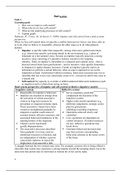Summary
Summary Bad Habits
- Course
- Institution
Summary of most mandatory articles of Bad Habits. Most articles are summarized by answering the learning goals and thus not individually summarized. Some empirical articles are also summarized. See below which articles are summarized. Task 1: -Dohle, S., Diel, K., & Hofmann, W. (2018). Execut...
[Show more]



